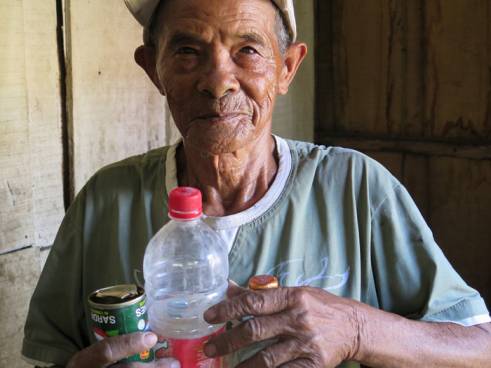By Carolyn Canham
HelpAge International and our partner in the Philippines, the Coalition of Services of the Elderly, have helped more than 140,000 people in the six months since Haiyan struck the Philippines on 8 November 2014.
How we’ve helped
In the last six months, we have delivered:
- emergency food packages to almost 8,000 households in hard-to-reach communities
- emergency shelter kits to 4,000 households, including tarpaulins and wood
- cash transfers to almost 16,000 people so they can buy basic items such as food
- rice and fertiliser to about 4,000 older farmers and fertiliser to a further 3,500
- support to almost 1,700 people in partnership with Mercy Malaysia to help older people recover from the trauma and loss caused by the typhoon
- health check-ups and medical examinations with free access to one month of appropriate medicines for more than 1,600 people in remote barangays in Leyte.
Long term recovery
The six-month anniversary of the typhoon comes as a timely reminder of the importance of including older people in every stage of an emergency response. The huge scale of the disaster means that while the emergency relief phase is now winding up, recovery is only just beginning.
“Many older people have still not fully rebuilt homes and livelihoods destroyed by the typhoon and it is essential that poor and vulnerable older people are included in ongoing recovery programmes,” said Ian Clarke, HelpAge’s Emergency Programme Manager in the Philippines.
“Helping people get their lives and livelihoods back on track is going to take a long time and a lot of resources.”
To help older people recover, our work is based on the needs identified in a survey of more than 7,000 older people in typhoon-affected areas. These needs include rebuilding livelihoods and shelter, accessing basic healthcare and addressing isolation.
Older people’s priorities
Financial help was the top priority among survey respondents, with 82% of older women listing it as a priority.
“Financial assistance allows older people to meet their immediate daily needs and make rational choices about how to spend their money, whether it be on healthcare, rebuilding their home or replanting their crops, ” said Clarke.
Apolinario is 86 and lives in North Cebu. He said: “I received 4,800 pesos (US$108) from HelpAge-COSE. I spent half of it on galvanised iron and labour to rebuild my shelter, 2,000 on materials so I could restart my business and 1,000 on rice and other necessities.
“It was important for me to restart my business. I now have enough income to support myself and even help my neighbours.”
After money, the top four priorities were, shelter, food, health and livelihoods.
Reach of the humanitarian response
In addition to identifying older people’s needs in an emergency, the survey also revealed how much help older people received in the wider humanitarian response to Haiyan.
The key findings included:
- 27% of older people said they received no help with shelter while 66% said they received insufficient shelter assistance.
- 22% said food aid were not appropriate for older people. For example those who need low salt or low sugar diets.
- 67% of older women and 69% of older men said their health deteriorated following the disaster.
- 27% of older people could not afford medicine and 15% could not afford doctor consultations.
